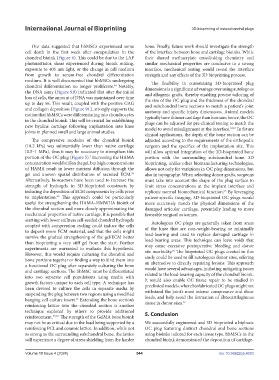Page 552 - IJB-10-4
P. 552
International Journal of Bioprinting 3D-bioprinting of osteochondral plugs
Our data suggested that hbMSCs experienced some bone. Finally, future work should investigate the strength
cell death in the first week after encapsulation in the of the interface between bone and cartilage bioinks. While
chondral bioink (Figure 6). This could be due to the LAP their shared methacrylate crosslinking chemistry and
photoinitiator, shear experienced during bioink mixing, similar mechanical properties are conducive to a strong
exposure to 405 nm light, or the change in cell medium interface, mechanical testing would reveal the interface
from growth to serum-free chondral differentiation strength and any effects of the 3D bioprinting process.
medium. It is well documented that hbMSCs undergoing The flexibility in customizing 3D-bioprinted plug
54
chondral differentiation no longer proliferate. Notably, dimensions is a significant advantage over using autologous
the DNA assay (Figure 9B) indicated that after the initial and allogenic grafts, thereby enabling precise tailoring of
loss of cells, the amount of DNA was maintained over time the size of the OC plug and the thickness of the chondral
up to day 56. This result, coupled with the positive GAG and subchondral bone sections to match a patient’s joint
and collagen deposition (Figure 9C), strongly supports the anatomy and specific injury dimensions. Animal models
notion that hbMSCs were differentiating into chondrocytes typically have thinner cartilage than humans; hence, the OC
in the chondral bioink. This will be crucial for establishing plugs can be adjusted for pre-clinical testing to match the
new hyaline cartilage following implantation into knee model to avoid misalignment at the interface. 63,64 In future
joints in planned small and large animal studies.
clinical applications, the depth of the bone section can be
The compressive modulus of the chondral bioink adjusted according to the requirements of the orthopedic
(18.2 kPa) was substantially lower than native cartilage surgeon and the specifics of the implantation site. This
(0.5–1 MPa), thus it may be necessary to strengthen this will allow optimal integration of the 3D-bioprinted bone
portion of the OC plug (Figure 5). Increasing the HAMA portion with the surrounding subchondral bone. 3D
5
concentration would stiffen the gel, but high concentrations bioprinting, unlike other biomanufacturing technologies,
of HAMA result in lower nutrient diffusion through the allows not only for variations in OC plug dimensions, but
gel and uneven spatial distribution of secreted ECM. also in topography. When selecting donor grafts, surgeons
56
Alternatively, bioreactors have been used to increase the must take into account the shape of the plug surface to
strength of hydrogels in 3D-bioprinted constructs by limit stress concentrations at the implant interface and
inducing the deposition of ECM components by cells prior replicate normal biomechanical function. By leveraging
65
to implantation. This approach could be particularly patient-specific imaging, 3D-bioprinted OC plugs would
60
useful for strengthening the HAMA–HMWHA bioink of more accurately match the physical dimensions of the
the chondral section and more closely approximating the damaged articular cartilage, potentially leading to more
mechanical properties of native cartilage. It is possible that favorable surgical outcomes.
starting with lower stiffness cell-seeded chondral hydrogels Autologous OC plugs are generally taken from areas
coupled with compression cycling could induce the cells of the knee that are non-weight-bearing or minimally
to deposit more ECM material, and that the cells might load-bearing and used to replace damaged cartilage in
survive the gradual strengthening of the gel/ECM better
than bioprinting a very stiff gel from the start. Further load-bearing areas. This technique can leave voids that
experiments are warranted to evaluate this hypothesis. may cause excessive postoperative bleeding and donor
66
However, this would require culturing the chondral and site morbidity. The bioprinted OC plugs created in this
bone portions together or finding a way to bind them into study could be used to fill autologous donor sites, offering
an alternative to directly repairing lesions. This approach
a functional OC plug after separately culturing the bone would have several advantages, including mitigating issues
and cartilage sections. The hbMSC must be differentiated related to the load-bearing capacity of the chondral bioink.
into two separate cell populations using media with
growth factors unique to each cell type. A technique has It would also enable OC tissue repair to be studied in
been devised to culture the cells in separate media by preclinical models, where biofabricated OC plugs might not
suspending the plug between two regions using a modified withstand the joint’s most intense compressive and shear
hanging cell culture insert. Extending the bone section’s loads, and help avoid the formation of fibrocartilaginous
61
67
reinforcing lattice into the chondral section is another tissue in donor sites.
technique explored by others to provide additional 5. Conclusion
reinforcement. 59,62 The strength of the GelMA bone bioink
may not be as critical due to the load being supported by a We successfully engineered and 3D bioprinted a biphasic
reinforcing PCL and ceramic lattice. In addition, while not OC plug featuring distinct chondral and bone sections
as strong as the surrounding subchondral bone, the lattice using bioinks tailored for each tissue type. hbMSCs in the
will experience a degree of stress shielding from the harder chondral bioink demonstrated the deposition of cartilage-
Volume 10 Issue 4 (2024) 544 doi: 10.36922/ijb.4053

